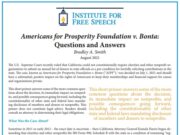| Subgrades | |
| Covered Speech: | A+ |
| Anti-SLAPP Protections: | A |
| Subscores | |
| Covered Speech: | 100 out of 100 points |
| Anti-SLAPP Protections: | 96 out of 100 points |
| Detailed Scoring on Anti-SLAPP Protections | |
| Suspension of Court Proceedings Upon an Anti-SLAPP Motion: | 18 of 20 points |
| Burden of Proof on Plaintiff to Defeat an Anti-SLAPP Motion: | 12 of 12 points |
| Right to an Immediate Appeal: | 25 of 25 points |
| Award of Costs and Attorney Fees: | 38 of 40 points |
| Expansive Statutory Interpretation Instruction to Courts: | 3 of 3 points |
State Anti-SLAPP Statute
California’s anti-SLAPP statute[1] protects “any act … in furtherance of the … right of petition or free speech under the United States Constitution or the California Constitution in connection with a public issue.”[2] Although discovery is stayed once an anti-SLAPP motion is filed, a court may nonetheless order that specified discovery be conducted if good cause is shown. To prevail against an anti-SLAPP motion, the respondent must establish a probability of prevailing at trial. California caselaw suggests that this probability is established if the respondent demonstrates both that the complaint is legally sufficient and that it is supported by a sufficient prima facie showing of facts to sustain a favorable judgment.[3] The statute provides for interlocutory appeal of an order granting or denying an anti-SLAPP motion. Except in narrow circumstances,[4] a court must award costs and attorney fees to the prevailing movant on an anti-SLAPP motion; conversely, if the court finds the motion to be frivolous or solely intended to cause unnecessary delay, then it must award costs and attorney fees to the prevailing respondent. If a plaintiff voluntarily dismisses her complaint after an anti-SLAPP motion has been filed, she cannot escape paying attorney fees and costs if the court determines the motion would have been granted.[5] This determination necessarily requires the court to consider the merits of the anti-SLAPP motion, even though the court does not have jurisdiction to grant or deny the underlying motion.[6] The scope of California’s anti-SLAPP statute was subsequently modified in minor respects;[7] a detailed description of those modifications is beyond the scope of this summary. In general, the anti-SLAPP statute instructs courts to interpret the statute’s language “broadly” – an instruction presumably designed to foil readings of the statute in a cramped or narrow way that would exclude marginal cases.
[1] Cal. Civ. Proc. Code § 425.16 through § 425.18.
[2] California caselaw suggests that the ‘commercial speech’ exception to the anti-SLAPP statute is narrow in scope. Simpson Strong-Tie Co., Inc. v. Gore, 49 Cal. 4th 12, 230 P.3d 1117, 109 Cal. Rptr. 3d 329 (Cal. May 17, 2010).
[3] Matson v. Dvorak, 40 Cal. App. 4th 539, 46 Cal. Rptr. 2d 880 (Cal. Nov. 21, 1995).
[4] Cal. Civ. Proc. Code § 425.16 (c)(2).
[5] Cal. Civ. Proc. Code § 425.16 (c)(2).
[6] Tourgeman v. Nelson & Kennard, 222 Cal.App.4th 1447 (Cal. Ct. App. 2014).













